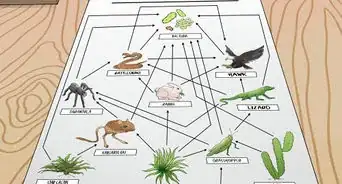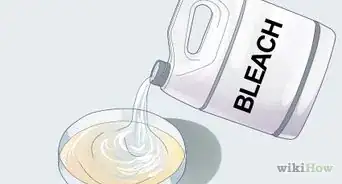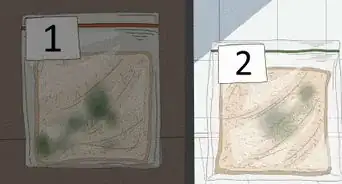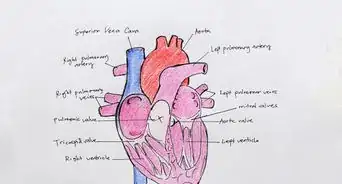wikiHow is a “wiki,” similar to Wikipedia, which means that many of our articles are co-written by multiple authors. To create this article, volunteer authors worked to edit and improve it over time.
This article has been viewed 38,485 times.
Learn more...
In nature, bacteria are found on practically every surface imaginable and unfortunately rarely exist in isolated populations containing a singular species of bacterium. This presents microbiologists with an interesting challenge obtaining isolated colonies of bacteria in a method that is both simple and rapid. The three sector streak or commonly referred to as the “T-Streak” is a basic, yet crucial skill used by microbiologist on a daily basis to isolate, identify, and study colonies of bacteria.
Steps
Drawing the T
-
1Flip to the back of a sterile petri dish containing agar. Draw a line starting slightly above the center point. Continue drawing the line until you hit the back plate's edge.
-
2Draw another line starting from the left side of the back plate until you hit the other side. This new line should be perpendicular to the original line, intersecting it at the starting point. The back plate of the petri dish should now be divided into three sectors, appearing as a large “T”.Advertisement
-
3Label the back plate of the petri dish with relevant laboratory information such as your initials, date, time and culture source.
Sterilizing the Inoculation Loop
- In order to eliminate the chance of contaminating the petri dish when inoculating the surface of the agar in the petri dish, the inoculation loop must be sterilized.
-
1Begin by connecting the Bunsen burner to a fuel source and igniting it.
-
2Insert the loop into the flame at a vertical angle. The object is to have the inoculation loop be slightly above the inner blue cone of the flame. Hold it there for several seconds.
-
3Remove the loop from the flame. At this point, the loop is sterile and extremely hot.
- The inoculation loop must be cooled, or else the residual heat will kill any bacteria taken from the culture.
-
4Cool the inoculating loop. Lift the lid of the petri dish just enough to insert the loop. Touch the outer edge of the nutrient agar. A sizzling sound should be heard upon first contact. Continue holding the inoculation loop against the surface for several seconds.
-
5Remove the inoculation loop from the petri dish. Avoid touching any other surface at this point, doing so will recontaminate the inoculation loop.
Inoculating the Loop with a Broth Culture
Inoculating the Loop with a Plated Culture
Inoculating the Nutrient Agar
-
1Lift the lid of the petri dish just enough to insert the loop. Beginning in the top sector of the “T’, lightly drag the inoculation loop across the surface of the nutrient agar in a zigzag pattern. It is important to stay within the region in which you are currently inoculating.
-
2Re-sterilize the inoculation loop now that the first sector of the “T” has been inoculated. Follow the method described in Sterilizing the Inoculation Loop. Remember to cool the inoculating loop on the edge of the nutrient agar that has not been contaminated with the original culture!
-
3Rotate the petri dish 90 degrees and lift the lid just enough to insert the loop.
-
4Start in the first sector. Lightly drag the inoculation loop across nutrient agar toward the second sector.
-
5Continue into the second sector. Lightly drag the inoculation loop across the nutrient agar in a zigzag pattern.
-
6Re-sterilize the inoculation loop now that the second sector of the “T” has been inoculated. Follow the method described in Sterilizing the Inoculation Loop. Remember to cool the inoculating loop on the edge of the nutrient agar that has not been contaminated with the original culture!
-
7Rotate the petri dish 90 degrees and lift the lid just enough to insert the loop.
-
8Start in the second sector. Lightly drag the inoculation loop across the nutrient agar towards the third sector.
-
9Continue into the third sector. Lightly drag the inoculation loop across the nutrient agar in a zigzag pattern.
Things You'll Need
- Bunsen burner
- Matches
- Mixed culture (e.g. Escherichia coli & Serratia Marcescens)
- Inoculation loop
- Sterile petri dishes containing a nutrient agar
-Step-1.webp)
-Step-2.webp)
-Step-3.webp)
-Step-4.webp)
-Step-5.webp)
-Step-6.webp)
-Step-7.webp)
-Step-8.webp)
-Step-9.webp)
-Step-10.webp)
-Step-11.webp)
-Step-12.webp)
-Step-13.webp)
-Step-14.webp)
-Step-15.webp)
-Step-16.webp)
-Step-17.webp)
-Step-18.webp)
-Step-19.webp)
-Step-20.webp)
-Step-21.webp)
-Step-22.webp)
-Step-23.webp)
























































